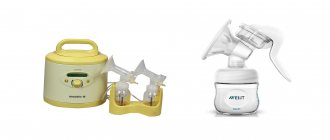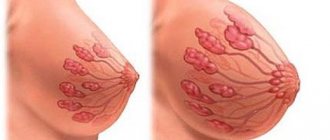Breastfeeding is a natural process, provided and established by nature itself, to ensure the vital activity and healthy development of the baby in the first years of his life. Despite this, due to various factors during breastfeeding, problematic situations may occur that require adjustment to maintain or restore this process.
One of the most common breastfeeding problems is uneven flow of milk to the mammary glands.
Breast imbalances: from genetics to baby habits
Asymmetry of the mammary glands can be caused by their anatomical structure (with a slight difference within the same size, it exists in almost 70 percent of women). A more noticeable discrepancy between these parameters is much less common and is associated with genetic hypoplasia of glandular tissue, in which the breasts do not enlarge even during pregnancy, although they still produce a small amount of milk. In addition to congenital asymmetry, visible differences in breast size also arise from the shape of the nipples. During breastfeeding, the right breast may become smaller than the left or, conversely, due to unequal emptying.
The unequal demand for the amount of mother's milk may change under the influence of:
- decreased patency of the excretory ducts due to their non-identical width;
- improper application to one of the mammary glands;
- uneven pumping;
- preferences in terms of comfort to support the baby at a more comfortable breast (for example, if the mother carries him in a sling next to her);
- night feedings on one side (at this time of day the maximum amount of milk is produced, and if the baby sucks on only one breast, the other will become noticeably smaller);
- treating lactostasis with the help of some folk remedies (vodka, alcohol or camphor, which suppress the production of the hormone oxytocin, which helps get rid of congestion simultaneously with the disappearance of lactation).
Pathological problems can also cause little milk in one breast. These are various injuries to the glandular tissue, previous operations or diseases: inflammation, lactostasis, mastitis. The baby’s habits also play a big role in the uniform sucking of mother’s milk. For example, the child does not fully grasp the nipple, which leads to painful cracks. Due to discomfort, a woman feeds her baby with such breasts less often, the flow of milk is blocked and the gland decreases in size.
When you may need the help of a surgeon
Conservative methods of dealing with imbalance will not help if a woman has congenital hypoplasia or an uneven volume of glandular tissue. Such violations are very rare. In other cases, asymmetry can be corrected without surgery.
If 3 months after breastfeeding the situation has not changed, one breast remains larger than the other, correction is carried out using:
- mesotherapy;
- massage;
- lipofilling of glands;
- myostimulation;
- hardware lifting;
- special linen;
- set of exercises.
These methods are used for mild asymmetry. They do not always give lasting results.

Plastic surgery through the introduction of implants allows you to restore the symmetry of the breast and will not affect subsequent pregnancies, childbirth and breastfeeding.
Asymmetry of the glands can be corrected with plastic surgery. The operation is performed 6 months after stopping breastfeeding. A silicone implant is inserted into the smaller breast. The product does not enter the milk ducts. If a woman plans to give birth again, she will be able to feed the baby without removing the implants. Most often, after breastfeeding, correction of not only the size, but also the shape of the breast is required.
Prolactin reflex - what is it?
Wise Mother Nature provided for the breast to be constantly replenished with milk during feeding. Therefore, the mechanism of stimulation of the nerve endings of the nipple is triggered every time the baby begins to absorb food. At this time, a nerve signal enters the anterior pituitary gland, which is responsible for regulating lactation processes and milk production thanks to the corresponding hormone. Stimulation of the nipple, causing increased secretion of the product and its entry into the glands, is called the prolactin reflex. Eating special foods and drinking plenty of fluids is only the nutritional basis for milk production. Putting the baby to the breast as often as possible and the sucking process allows the glands of the nursing mother to maximize their growth. The amount of milk in them also increases.
How to avoid asymmetry
To prevent a visually noticeable difference between the glands, a nursing mother is recommended:
- Learn the technique of properly attaching your baby. It is almost always possible to organize comfortable feeding over time. Even women with inverted nipples and other anatomical features.
- Level the frequency and degree of emptying. This is the basic rule, which during breastfeeding will help avoid a situation where one mammary gland becomes visually larger than the other.
- Avoid camphor oil if you have lactostasis. If problems arise, you need to contact a specialist. Traditional treatment prevents asymmetry and possible complications of congestion.
- Reduce (or better yet eliminate) pumping. The procedure will only make the situation worse. If absolutely necessary, you can express a little milk by hand.
- Smoothly complete the GW. Abrupt weaning provokes mammological diseases. Not only the number of feedings should be reduced, but also the feeding time.
Breast asymmetry is an aesthetic problem that requires correction. If a woman manages to properly organize feeding and complete lactation gradually, the glands will quickly restore their shape. If there are noticeable deviations, it is advisable to correct the bust using special underwear.
Mommy worries
For women for whom the birth of their first child was a real event, insufficient lactation in one of the mammary glands can cause great distress. Experts warn that there is no need to be upset about this. According to medical statistics, less than three percent of new mothers suffer from the inability to breastfeed. This condition is caused by serious hormonal imbalances. Under normal conditions, in the first months after childbirth (within two to three), the breasts of a nursing mother undergo a natural process of adaptation.

Smaller breasts generally need to be stimulated more frequently and for longer periods of time. In this way, it is possible to align requests for product production, thereby equalizing the size of the bust on both sides. Experts have long found out that the amount of food produced for a child does not depend on the size of the glands. It often happens that large breasts produce little milk, and women with the first number feed babies for up to a year or more. In the reviews there are examples of breastfeeding in mothers with a small size of up to one and a half years and even a year and eight months.
When will your breasts return to normal?
If a woman follows feeding rules, her bust size will even out after 1-2 months. The situation may repeat itself, so you need to monitor the uniform emptying of the glands.
Abrupt weaning does not solve the problem. Natural completion of breastfeeding without the use of hormonal drugs is the best way to avoid asymmetry.
After cessation of lactation, the bust is restored in 1-3 months. The timing depends on the individual characteristics of the organism.
Causes of painful sensations in the breasts during feeding
Discomfort in the area of the nipples and mammary glands in general in a nursing mother during the period of normalization of the lactation process can be associated with a powerful influx of milk (in the form of slight distension) and injury to the delicate skin of the nipples, which are not sufficiently roughened (usually it takes about two days for them to adapt weeks). If a woman regularly applies baby to the glands in accordance with the regimen and rules, then the natural pain in the breasts during feeding will very soon go away.
If unpleasant sensations do not occur in the first days of lactation, but much later, when the feeding regimen is already balanced, then their causes may be:
- powerful flow of milk directly during the process;
- formation of cracks and wounds on the nipples, infection of injuries with bacteria or fungi;
- milk stagnation (or lactostasis);
- mastitis;
- mastopathy.
To find out what causes chest pain during feeding and to get advice on how to avoid injury to the nipples, establish the correct process of providing the baby with breast milk, or cure the disease, you need to visit a doctor immediately.
What causes lactostasis and how to cope with it?
Lumps in the breast, which appear due to the fact that mother’s milk does not come out of the clogged lobules, are a common phenomenon among young mothers who are faced with gland pain for the first time. What can cause lactostasis?

This:
- too long pauses between feedings, causing stagnation of milk (advices to save the product so that it lasts for the evening lead to lumps!);
- a limited period of food intake, when the baby only manages to drink foremilk, and the more difficult to suck, but fatty and nutritious milk remains in the breast, clogging the ducts;
- feeding in the usual position, when the same lobules are emptied, and compactions appear in others;
- prolonged sleep on one side (facing the baby), leading to the appearance of lumps in the armpit area;
- tight and uncomfortable underwear;
- fatigue and chronic lack of sleep;
- monotonous homework;
- the predominance of fatty foods in the diet;
- sudden cold snap (you should pay special attention to the prevention of lactostasis).
As a result of exposure to any of the negative factors, there is little milk in one of the mammary glands. What to do in this case? Gynecologists advise avoiding mechanical kneading of lumps in the chest with your hands, which can cause harm and aggravate the situation. In addition, you should not limit your fluid intake. The myth that it is prohibited to breastfeed a child affected by lactostasis is unfounded. This must be done, because the baby can use sucking to free the clogged lobules from stagnation of milk in the most painless and efficient manner. Just before breastfeeding, you need to position it so that the baby’s chin is directly under the seal - this way you can achieve the maximum effect, because the child stimulates the gland most strongly with the help of a vacuum under the tongue during sucking. By applying the baby in different positions, mommy can achieve gentle emptying of all the lobules. If it is difficult for a child to completely suck out the mother's milk, then the remaining milk must be expressed.
Is uneven lactation dangerous?
Is uneven lactation dangerous for a baby? Breastfeeding is important for a child. You cannot stop breastfeeding for aesthetic reasons. Milk is not only a valuable nutrient substrate, it is the “organizer” of the child’s immunity. “Artificial people” more often suffer from colds, suffer from allergies and gastrointestinal pathologies.

“One-sided” feeding does not affect the health of the baby in any way. The main thing is to feed him for at least a year.
Now let's talk about mom. You can read that with asymmetrical lactation, the risk of cancer of the “lazy” breast increases. This is true, but:
- Doctors are not ready to say how significantly the probability increases;
- the presence of a risk does not at all indicate the obligatory development of breast cancer (cancer);
- This risk increases due to many factors, such as smoking, abortion, trauma and surgery on breast tissue.
Lactation crises
If your baby becomes restless during feeding, it may be that he is not getting enough breast milk. Such situations arise to varying degrees in each woman, due to leaps in the development of the baby, when its nutritional needs increase. The first stage of milk shortage may appear on days 21-45 after birth, and subsequent fluctuations in the supply and demand ratio may become noticeable at the 3rd, 7th, 11th and 12th months of breastfeeding. The duration of lactation crises is individual and can normally range from 2-3 days to a week. This does not mean that the mother has less milk, but during this time the glands have time to adapt to new demands. During this period, first-time women, worried that the baby is not getting enough to eat, may make a mistake and start feeding with formula.

The result is often the baby's reluctance to suckle on breast milk, especially the rear nutritive part. Therefore, pediatricians recommend putting the baby to the breast as often as possible at this time and feeding longer than usual, including during the night period, which is favorable for milk production. Advice to give babies a pacifier, supplement with water, use bottles with nipples, doubt the availability of a sufficient amount of mother's milk, and give up without bothering to fight for natural feeding of the child are considered harmful.
If there is too much breast milk
Some mothers produce more milk than their babies need. This situation is quite common in the first weeks of breastfeeding, but sometimes it continues for a longer time.
Your body produces too much breast milk if:
- There is a feeling that the chest is quickly filling.
- Although breasts feel softer after breastfeeding, they are often hard and hard.
- The baby gags and choke (especially at the beginning of feeding) and often does not take the second breast.
- The baby burps quite a large volume at the end of the feeding.
- Often a baby gains weight quickly; however, in extremely rare cases a slight increase may occur.
- Your baby may be very fussy between feedings, especially in the evening.
- You change diapers too often (i.e. more than the usual 5 wet disposables or 6-8 reusable diapers in 24 hours).
- The baby will typically have stools at each feeding, often green and foamy (and possibly large stools as well).
- You exhibit symptoms of lactase deficiency.
In the first few weeks, it often happens that mothers produce more milk than they need. In the early stages, this can lead to engorgement of the mammary glands. Sometimes it takes up to 6 weeks for the mammary gland to adjust to producing the optimal amount of milk for your baby.
You can help your breasts adjust to producing the amount of milk your baby needs in the following ways:
- Feed on demand, not on a set schedule. Breastfed babies usually need at least 8-12 feedings per day.
- Learning to recognize your baby's signals will help you understand when he wants to eat.
- Listen to your body and wake your baby to feed if your breasts become full and uncomfortable.
- Pump a small amount for relief if your breasts are too full and it is necessary for your comfort or for proper latching. (Expressed milk can be donated through the website www.milkmama.info to babies in need - editor's note)
- Give your baby a chance to finish the first breast before offering the second, rather than setting a time limit for feedings.
- Take care to apply correctly. If the baby is latched correctly, he will empty the breast better.
- Avoid giving your baby formula or any other liquid (including water) unless medically indicated.
These tips will also be helpful if you continue to produce too much milk after the first few weeks.
From a very early age, some babies prefer to feed from only one breast at a time. This is completely normal and can help you quickly stabilize your milk supply.
Sometimes breast duty may be recommended for mothers who are producing too much milk. This is said when the mother attaches the baby to only one breast for a certain time (for example, 3-4 hours) at each feeding. Then, when the next period of time arrives (for example, the next 3-4 hours), the baby is placed on the other breast at each feeding.
Feeding from only one breast for a certain period of time means that each time the baby returns to the breast, he receives a smaller volume of breast milk, which is higher in fat and calories. The length of time depends on how much milk the mother produces. “Breast watch mode” is almost always a temporary measure. Eventually, most babies begin to latch on to both breasts during the same feeding.
It is also possible that you are producing normal amounts of breast milk but have too much of a let-down reflex if:
- The baby is worried, pushes away from the breast and choke at the beginning of feeding, at the first flush, but remains calm and content during the rest of the feeding time.
- The baby is gaining weight adequately, not too quickly.
There are many ways to prevent and treat breast engorgement, hyperlactation or a strong let-down reflex. The Australian Breastfeeding Association (ABA) publishes an easy-to-read booklet called Breastfeeding and Milk Supply, which contains advice on how to manage breast engorgement and increased milk production, control an overactive let-down reflex, and time-tested tips How to calm a restless baby. You can also contact counselors or members of breastfeeding support groups if necessary. (Contacts of Russian-speaking consultants and breastfeeding support groups can be found here)
Different amounts of milk in the mammary glands are not an excuse to wean a child from the breast
In the first three months after birth, the balance between the baby's needs and the mother's milk production occurs. Over time, the ducts expand, the product becomes less greasy and its quantity begins to return to normal, meeting the child’s needs. But if more milk arrives in one breast, then the woman experiences discomfort: the overfilled mammary gland hurts and aches. She is often susceptible to lactostasis. The child experiences discomfort, grasping the nipple, choking and at the same time swallowing portions of air, which subsequently leads to regurgitation and painful colic in the abdomen. In this case, feeding also causes not only pain to the mother: milk is knocked out of the nipples in dense streams, leaking, wetting clothes and leading to irritation on the skin. In addition, excess product provokes the appearance of stretch marks (stretch marks).
What rules should you follow to avoid discomfort when feeding? Need to:
- Feed the baby with one breast at a time;
- monitor the technique of the baby's nipple latching (incorrect latching of the areola makes nutritious hind milk inaccessible, and sweet foremilk is absorbed quickly - a hungry baby asks to eat, stimulating new production and an influx of more and more product);
- Overfilled breasts must be pumped a little before feeding to allow the baby to easily latch on to the nipple.
It is better to feed him in an upright position or holding the baby at an angle (so that the head is higher than the stomach). If there is more milk in one breast than is needed to feed the baby at one time, then the remaining milk is expressed to prevent the risk of stagnation (lactostasis) and the appearance of lumps. Breasts designed in this way may leak, so it is necessary to place a sanitary absorbent pad in the bra. The second gland also needs to be expressed if the child has already eaten. The fact is that during weaning (even temporary), mother's milk in the breast, which has little of it, quickly involutions.
What to do if lactation has stopped completely on the “lazy” side?
If you are healthy, in one gland there is no milk at all, but in the other there is, you need to continue breastfeeding (breastfeeding) with the nipple that secretes nutrient fluid. Mothers fed healthy, strong children with one breast. This is a fact known to medicine.
What to do if all efforts were in vain and the problematic gland practically does not secrete nutritious secretions, the breasts have become asymmetrical - one gland looks larger?
As we wrote above, do not be discouraged and continue breastfeeding. As for asymmetry, after completion of breastfeeding, glandular tissues involute. And the difference will not be so noticeable.
In doing so, follow a few simple rules. Palpate the “lazy” gland daily for compactions; if a nutritious secretion is produced, however little, the lack of outflow becomes the cause of lactostasis and mastitis. If you feel lumps, take a warm shower and offer your baby a small nipple and express the rest of the milk.
Baby's habits: if he takes only one breast
From the very beginning of natural feeding of the baby with mother's milk, it is necessary to strictly ensure that the baby does not develop a “favorite” breast. The habit of lying on one side in the mother's tummy during pregnancy may cause him to give preference to the mammary gland that is located closer to his traditional position. It is necessary to alternately offer the right and then the left breast during feeding, making sure to remember which side the baby was applied to last time. During a lactation crisis, when there is less milk, you can use both breasts in one feeding, but at the next meal give the baby the one that was previously the second. To stimulate the production of the product, experienced mothers advise placing the little one more often on the less mammary gland. And after the feeding session, you must express every drop. This will help increase the amount of natural maternal product in one breast (there is little milk in it, and therefore the baby refuses to suckle from it).

Breastfeeding consultants advise putting your baby to the breast more often at night, especially from 3 to 5 am, when the body actively synthesizes prolactin, a hormone that affects the formation of milk in the female mammary gland. Moreover, a sleepy baby may not notice that in order to satisfy his hunger he was given the wrong breast that he loves. A warm shower, compresses or baths with moderately hot water help to increase the amount of milk before feeding - procedures that help expand the ducts and make it easier for the baby to suck milk. When choosing the optimal water temperature for such manipulations, care should be taken not to harm the delicate skin of the nipples and mammary glands in general.
One breast produces milk, but the other does not
Why does it happen that there is little milk in one breast, but more than enough in the other? After all, prolactin and oxytocin, which stimulate the production of maternal product, enter each breast. The production of food for the baby is controlled by the glands themselves due to inhibitors contained in the maternal product. If, for example, there is less milk in the right breast, then these substances stimulate its further secretion with the help of glandular cells. Otherwise, they inhibit the formation of the product, protecting the glands from overflowing.

Nature provides for the factor of stopping the baby from sucking at the breast: in this case, along with the milk, the “litmus test” (inhibitor) is removed from the gland for further formation of the product. If there is more milk in one breast and the child sucks only the areola on it, then the product will arrive exactly at this address, increasing the size of the gland. While on the other hand, the breasts will shrink, reducing lactation if you do not express milk regularly. Advice to eat more, drink special teas and “Apilak”, healing herbal infusions and other wishes will not be beneficial if the child does not suckle at a specific breast. In order for constant milk secretion to occur, it is necessary for the baby to stimulate the nipples correctly and often.
Myths and misconceptions
There are many erroneous opinions about how to breastfeed a baby, even in our enlightened age. For example, the advice that a newborn should not be held at the breast for more than 5 minutes to avoid the appearance of cracks does not stand up to the criticism of neonatologists. Their answer explains that you need to feed the baby until he frees the breast on his own. And the formation of cracks is associated with two reasons: excessive sanitation of the nipples (with soap and brilliant green), which destroys the protective layer of the areola, and the baby’s improper grasping of it for sucking.
A negative review from a patient whose doctor recommended saving milk and feeding the baby infrequently so that he has enough for dinner in the evening, is supplemented by the comment that in this case one should expect a decrease in the amount of milk produced and a deterioration in the lactation process. The widespread opinion that children suck out a sufficient portion of the mother's product already in the first 5-10 minutes of feeding is true only for older children. It is difficult for newborns to get enough so quickly, because they are still learning to suck and not everyone is able to do it productively. In addition, the rate of milk flow in the mother plays a significant role in this process, because in some women the secretion of the product occurs in small portions and occurs several times during one feeding.










